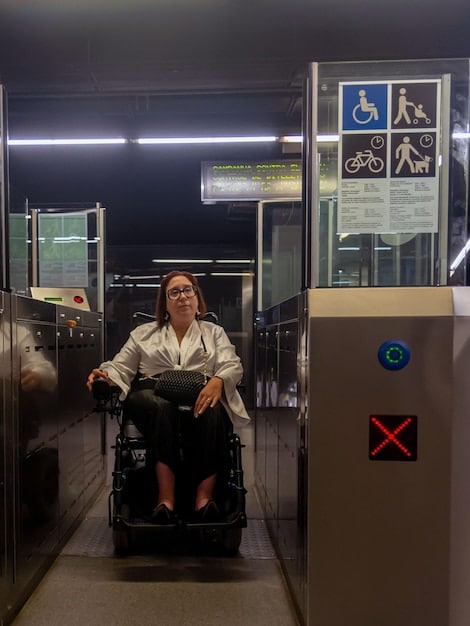Autonomous Vehicles in the US: A Look at the Future of Transportation

The Future of Transportation: Exploring the Potential of Autonomous Vehicles in the US reveals how self-driving technology promises to revolutionize mobility, enhance safety, and reshape urban landscapes, while also examining the significant challenges and opportunities that lie ahead for widespread adoption in the United States.
Imagine a world where traffic jams are relics of the past, and commutes are opportunities to relax or work. The Future of Transportation: Exploring the Potential of Autonomous Vehicles in the US offers a glimpse into this possible reality, examining the transformative impact of self-driving technology on American roads and beyond. Get ready to explore the exciting possibilities and the challenges that lie ahead.
The Dawn of Autonomous Vehicles: A New Era in Transportation
Autonomous vehicles (AVs) are poised to revolutionize how we move people and goods across the United States. These self-driving cars, trucks, and buses promise to improve safety, increase efficiency, and enhance accessibility for millions of Americans. Let’s delve into what makes this technology so disruptive and explore its potential impact on our society.
What are Autonomous Vehicles?
Autonomous vehicles, also known as self-driving cars, use a combination of sensors, software, and powerful computers to navigate roads without human intervention. These vehicles can perceive their surroundings, make decisions, and control their movement to safely reach their destination.
Levels of Automation
The Society of Automotive Engineers (SAE) has defined six levels of driving automation, ranging from 0 (no automation) to 5 (full automation). Understanding these levels is crucial to grasp the current state of AV technology and its future trajectory.
- Level 0: No Automation: The driver is entirely responsible for all aspects of driving.
- Level 1: Driver Assistance: The vehicle provides some assistance, such as adaptive cruise control or lane keeping assist.
- Level 2: Partial Automation: The vehicle can control both steering and acceleration/deceleration in certain conditions.
- Level 3: Conditional Automation: The vehicle can handle most driving tasks in specific environments, but the driver must be ready to intervene.
- Level 4: High Automation: The vehicle can perform all driving tasks in certain conditions, even if the driver does not respond to a request to intervene.
- Level 5: Full Automation: The vehicle can perform all driving tasks in all conditions without any human intervention.
Currently, most commercially available vehicles offer Level 2 automation, while the development of Level 4 and 5 vehicles is ongoing.
In conclusion, the rise of autonomous vehicles represents a paradigm shift in the transportation industry. By understanding the different levels of automation and the underlying technologies, we can better appreciate the potential benefits and challenges of this transformative technology.
The Potential Benefits of Autonomous Vehicles
Autonomous vehicles have the potential to bring about significant improvements in various aspects of our lives. From enhanced safety to increased accessibility and reduced traffic congestion, the benefits are numerous and far-reaching. Let’s explore some of the most promising advantages of AV technology.
Improved Safety
One of the most compelling arguments for autonomous vehicles is their potential to drastically reduce traffic accidents. Human error is a leading cause of accidents, and AVs can eliminate many of these errors by relying on sensors and software to make driving decisions.
Increased Accessibility
Autonomous vehicles can provide greater mobility for individuals who are unable to drive due to age, disability, or other limitations. This technology can open up new opportunities for these individuals, allowing them to access employment, healthcare, and social activities more easily.

Reduced Traffic Congestion
Autonomous vehicles can communicate with each other and coordinate their movements, leading to smoother traffic flow and reduced congestion. By optimizing routes and minimizing stop-and-go traffic, AVs can help alleviate traffic jams and improve overall travel times.
The benefits of autonomous vehicles extend beyond safety, accessibility, and congestion. AVs can also lead to reduced fuel consumption, lower emissions, and more efficient use of parking spaces. As the technology continues to develop, we can expect even more innovative applications and advantages to emerge.
Challenges and Obstacles to Adoption
While the potential benefits of autonomous vehicles are substantial, several challenges and obstacles must be addressed before widespread adoption can occur. These challenges range from technological limitations and regulatory hurdles to public perception and ethical considerations. Let’s examine some of the key obstacles that need to be overcome.
Technological Limitations
Despite significant advancements in AV technology, there are still limitations that need to be addressed. Autonomous vehicles can struggle in certain weather conditions, such as heavy rain or snow, which can impede the performance of sensors. Additionally, AVs may have difficulty navigating complex or unpredictable environments, such as construction zones or areas with heavy pedestrian traffic.
Regulatory Hurdles
The regulatory landscape for autonomous vehicles is still evolving, and there is a lack of clear and consistent regulations across different states. This uncertainty can create challenges for manufacturers and operators of AVs, as they need to comply with different rules and requirements in different jurisdictions.
Public Perception and Trust
Public perception of autonomous vehicles is mixed, with some people expressing excitement and optimism, while others are concerned about safety and job displacement. Building public trust in AV technology is crucial for widespread adoption, and this requires transparent communication, rigorous testing, and a focus on safety.
- Cybersecurity Threats: AVs are vulnerable to cybersecurity threats, which could compromise their safety and security.
- Ethical Dilemmas: AVs may face ethical dilemmas in certain situations, such as unavoidable accidents, where they need to make split-second decisions that could result in injury or death.
- Job Displacement: The widespread adoption of AVs could lead to job displacement for professional drivers, such as truck drivers and taxi drivers.
Addressing these challenges and obstacles is essential to unlock the full potential of autonomous vehicles. By investing in research and development, establishing clear regulations, and engaging in open dialogue with the public, we can pave the way for a safe and successful transition to a future with autonomous transportation.
The Role of Infrastructure in Supporting Autonomous Vehicles
The successful deployment of autonomous vehicles depends not only on the vehicles themselves but also on the infrastructure that supports them. Smart roads, reliable communication networks, and accurate mapping data are all essential components of a robust AV ecosystem. Let’s explore the key aspects of infrastructure that need to be developed and enhanced to facilitate the widespread adoption of autonomous vehicles.
Smart Roads
Smart roads are equipped with sensors, cameras, and communication devices that can provide real-time information to autonomous vehicles. This information can include traffic conditions, weather alerts, and road closures, allowing AVs to make informed decisions and navigate safely.
Communication Networks
Reliable communication networks are crucial for enabling autonomous vehicles to communicate with each other, with infrastructure, and with cloud-based services. 5G technology offers the potential to provide the high bandwidth and low latency required for seamless communication in an AV ecosystem.

Mapping Data
Accurate and up-to-date mapping data is essential for autonomous vehicles to navigate roads and understand their surroundings. High-definition (HD) maps provide detailed information about lane markings, traffic signs, and other features, enabling AVs to plan their routes and avoid obstacles.
Investing in infrastructure improvements is critical to create a conducive environment for autonomous vehicles. By developing smart roads, enhancing communication networks, and creating accurate mapping data, we can pave the way for a safe and efficient AV ecosystem that benefits all members of society.
The Economic and Social Impact of Autonomous Vehicles
Autonomous vehicles have the potential to transform not only the transportation sector but also the broader economy and society. From creating new business opportunities to reshaping urban landscapes and changing consumer behavior, the impact of AV technology is likely to be profound. Let’s examine some of the key economic and social implications of autonomous vehicles.
Economic Growth
The development and deployment of autonomous vehicles can spur economic growth by creating new jobs, attracting investment, and increasing productivity. The AV industry is expected to generate trillions of dollars in revenue over the next few decades, and this growth can benefit many sectors of the economy.
Urban Redevelopment
Autonomous vehicles can reshape urban landscapes by reducing the need for parking spaces, improving traffic flow, and enabling more efficient use of land. This can lead to more walkable and livable cities, with more green spaces and public amenities.
Changing Consumer Behavior
Autonomous vehicles can change consumer behavior by making transportation more convenient, affordable, and accessible. This can lead to increased mobility, more travel, and a shift in consumer spending patterns.
The economic and social impact of autonomous vehicles is far-reaching and complex. While there are concerns about job displacement and other potential negative consequences, the overall impact is expected to be positive. By embracing AV technology and preparing for the changes it will bring, we can create a more prosperous and equitable future for all.
The Future of Autonomous Vehicles in the US: A Vision
Looking ahead, the future of autonomous vehicles in the US is filled with both promise and uncertainty. While it is difficult to predict exactly how the technology will evolve and how society will adapt, it is clear that autonomous vehicles have the potential to transform our lives in profound ways. Let’s explore a possible vision of the future with AVs.
Widespread Adoption
In the coming years, we can expect to see a gradual increase in the adoption of autonomous vehicles, starting with commercial applications such as ride-hailing services and delivery trucks. As the technology matures and regulations become clearer, we can expect to see more and more privately owned AVs on the roads.
Integration with Public Transportation
Autonomous vehicles will likely become integrated with public transportation systems, providing flexible and on-demand transportation options for commuters. Autonomous shuttles and buses can supplement traditional public transit routes, providing a more convenient and efficient way to get around.
Smart Cities
Autonomous vehicles will play a key role in the development of smart cities, where technology is used to improve the quality of life for residents. AVs can communicate with other smart city systems, such as traffic management systems and energy grids, to optimize resource utilization and reduce environmental impact.
The future of autonomous vehicles in the US is bright, but it requires careful planning, collaboration, and a commitment to safety and innovation. By embracing the potential of AV technology and addressing the challenges along the way, we can create a transportation system that is safer, more efficient, and more accessible for all Americans.
| Key Point | Brief Description |
|---|---|
| 🚗 Enhanced Safety | AVs can reduce accidents by minimizing human error. |
| 🧑🤝🧑 Increased Accessibility | AVs provide mobility for those unable to drive themselves. |
| 🚦 Reduced Congestion | Autonomous vehicles can smooth traffic flow and reduce congestion. |
| 🌐 Infrastructure Support | Smart roads and reliable networks are essential for AV success. |
Frequently Asked Questions
▼
The main benefits include enhanced safety by reducing human error, increased accessibility for those unable to drive, and reduced traffic congestion through optimized routes and coordination.
▼
Challenges include technological limitations in adverse conditions, regulatory hurdles due to inconsistent laws, and building public trust in the safety and reliability of AVs.
▼
AVs are expected to spur economic growth by creating new jobs, attracting investment, and increasing productivity. They may also reshape urban landscapes and change consumer behavior.
▼
Infrastructure is crucial, requiring smart roads with sensors, reliable communication networks for real-time data exchange, and accurate mapping data for precise navigation and awareness.
▼
There are six levels, from 0 (no automation) to 5 (full automation). Current commercially available vehicles are mostly at Level 2, with ongoing development towards Levels 4 and 5 for complete autonomy.
Conclusion
The future of transportation in the US is undeniably intertwined with the advancement of autonomous vehicles. While challenges persist in technology, regulation, and public acceptance, the potential benefits of enhanced safety, increased accessibility, and reduced traffic congestion make autonomous vehicles a transformative force to watch. As infrastructure evolves to support these vehicles and public trust grows, the vision of a future with autonomous transportation becomes increasingly attainable, promising a more efficient and equitable transportation system for all.





